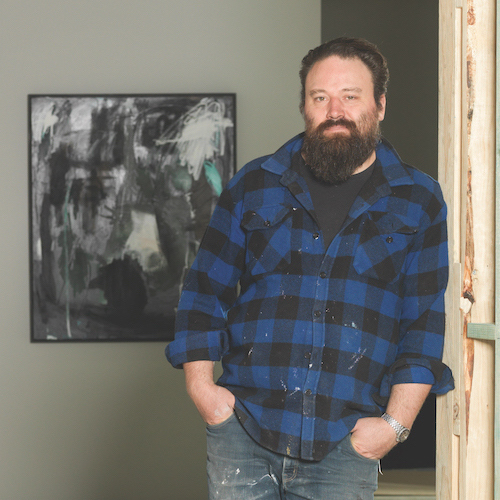James Makin Gallery: Tried, Tested and Triumphant
Now in its third iteration, Melbourne’s James Makin Gallery in its new Collingwood space, is refined, serious, innovative and welcoming.
Words: Briony Downes
Photography: Elke Meitzel
“When I was about 12 years old, my father remembers I sat him down and confessed I did not want to become an artist,” says James Makin. While this would be an unusual conversation for most, James is the son of renowned Australian landscape artist, Jeff Makin – a painter who spent his formative years working en plein air in the bush and learning from iconic artist Fred Williams.
Starting in his early teens, James had a different plan. “I wanted to be an art dealer. It was something I always felt I was going to do.” With this in the back of his mind, James studied Fine Art at Monash University in Melbourne and closely followed the careers of contemporary art dealers Bernard Jacobson and Larry Gagosian.
Following a series of jobs at Leonard Joel Auctioneers and Port Jackson Press, James achieved his original goal in 2003 when he opened his first gallery on High Street in Armadale, Victoria. Now working alongside co-director Jessica Velasquez and curators Amy Turrini and Laura Kirkham, James has just opened the third version of his gallery – a newly designed space on Islington Street in Collingwood.
Collaborating with Tristan Wong, Director of SJB Architects, James has maintained a design subtly similar to his previous galleries, employing high ceilings, polished floors and ample natural lighting. Possessing a stockroom, two exhibition spaces, reception and a bar custom-made by his brother Hugh Makin, James is particularly fond of the gallery’s new viewing room. Set up like a private lounge with a well-stocked bookshelf and sound-proof walls, James wanted to give visitors a place to experience art in a relaxed setting. “A big part of the whole design was to create a welcoming environment,” James explains. “We’ve all had the experience of going into a gallery and having someone eyeball you up and down from over a high desk. It’s really elitist and judgmental. We want to be totally the opposite.”
Describing those he represents as “rock stars,” James has handpicked artists at all stages of their careers working across painting, photography and sculpture. From well-established senior painters Godwin Bradbeer and Jeff Makin to the character driven contemporary photography of Lisa Tomasetti and street art aesthetics of Patrick Dagg, the continued success of the gallery remains underpinned by a bevy of hard-working artists. Speaking about the impetus for leveling up his gallery space, James says, “Artists live and breathe their work. They don’t do 40-hour weeks, they do 100-hour weeks. You have to respect that. I need to provide the best possible environment to present their work for sale. When artists walk in, I want them to know we have their back and when clients walk in, they can see we take art very seriously.”
Growing up the son of a painter, James has experienced firsthand how artist’s work and also how much impact good sales can have on an artist and their families. “Having been on the receiving end of this has given me a really good realisation of what artists expect a dealer to do,” he says. “I am a small business, but we work really hard for our artists. When my dad’s dealers did well, it made a big difference to us as a family.”
Even in the throes of a global pandemic, the gallery found ways to continue support- ing their artists. “I have an excellent team around me. We all sat down in March 2020 when the world was about to swallow us up and just brainstormed a way through.” Recalling overseas trips James took with Hugh in their youth, a significant influence on the new gallery design is museum architecture and lighting. While traveling, the brothers visited galleries in London, Paris, Barcelona and New York.
It was museum spaces like the Getty Center in Los Angeles that James liked the most. Closer to home, the National Gallery of Victoria (NGV) has also been a constant inspiration. “At the NGV Tony Ellwood has developed an exceptional model to follow,” James says. “The space is architecturally interesting with high ceilings and the curatorship of the exhibitions vary. When you are in the commercial gallery sector (even though our budgets differ dramatically), you want to learn from what the best people are doing and how they are doing it.”






